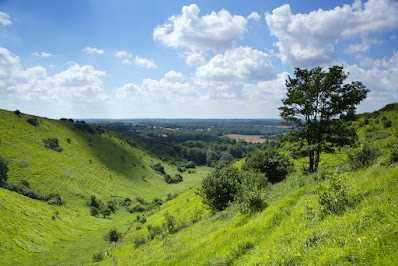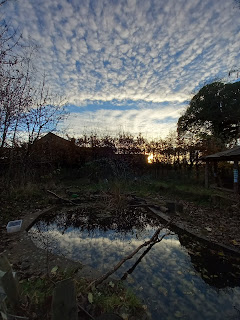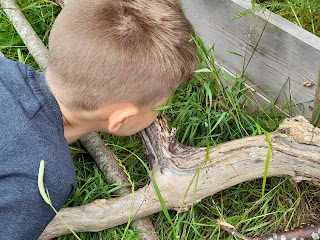We are in a very scenic part of Kent (see the Explore Kent photo below), just within the boundaries of a designated Area Of Outstanding Beauty. It's green rolling hills and stunning cathedral city, Trees and nature all around, birdsong and tractors causing traffic jams on a daily basis! I have no idea how the prolific orchards and vineyards around us manage their land because for us, it's hard work!
Every now and then the children rediscover the rocks in the Dig Pit. In all honesty, it's not just at the Dig Pit. We are based on top of a hill which I think is an undiscovered solid flint MOUNTAIN (as that's the only reasonable explanation for the quantity!), and once you strip off the topsoil you hit the rocks!
This makes gardening with the children a little fraught, it takes a heavy toll on the digging tools, and opens up a huge world of imagination, history, geography, geology, and interest for the children.
Every flint nodule we dig up is a 'tooth'. The speculation on whose tooth is rife, from dinosaur to shark, from sabre tooth tiger to Gruffalo.It's obvious that this area was once underwater and this would've been a very long time ago! We know this because we have found fossilised coral which I have been informed is from 236 Million - 492 million years ago! Plus the imprint of sea urchin shapes, an entire sea urchin, as well as tiny creatures I can't even identify via Google Lens!
From what I've found out, and I'm going to quote this as I have yet to entirely take it all in, is that the school sits on a plateau of:
Lewes Nodular Chalk, which comprises interbedded, hard to very hard, nodular chalks, with soft to medium–hard chalks and marls. The first persistent seams of flint occur near the base. The flints are typically black or bluish-black with a thick white cortex.
I can attest to the VERY HARD part! We have very little white chalk unlike the cliffs at Dover!
Underneath this 'chalk and flint' is, more chalk and flint...
Seaford Chalk Formation, which is composed primarily of soft, smooth, blocky, white chalk with abundant seams of large nodular and semitabular flint, and thin harder nodular chalk beds near the base.
We never make it to 'softer' areas as our tools can attest!
If you've ever wondered about the geology of your own site, or home, or school, can I say it's easy to kill an hour browsing on here:
although this link is probably focused on our setting so you'll need to zoom out and scroll to find you!
For us what it has done is throw up an aspect of Forest School I was never really trained in - geology. The children find rocks that they are curious about and of course, the adults are their first point of call when they have questions. We are always honest with them and say we don't know (if we don't) but we have a couple of books and the internet to help us out. However, the range and scope in a book is huge! It's often really hard to match an image, and guide books cover all geologies or all fossils, and the lack of local focus means we can't always answer their questions.
This doesn't stop the adventures. They set up cleaning stations so they can see the rocks more clearly, they carefully scrape them out of the places they have embedded themselves, they are in awe of the shapes and amazed at the patterns.
The physicality of digging them up is a challenge alone. Their perseverance, is amazing and some of the lumps that come up are bigger than a rugby ball and weigh over a kilo!
Sometimes they focus on small pieces, using magnifiers to look in detail and examples in books to identify what they see - it is almost exclusively flint!
The occasional pebble, especially if broken, may throw in a bright colour, such as red, then the cry 'RUBY!' goes up and everyone flocks to the treasure hunt!
The motivation to find more, to dig deeper, to set up teams of 'miners' and 'cleaners', to organise equipment and guides so they 'know' what they have, can continue over weeks. Usually, we are rewarded with a potential fossil at each session. Some of these are fracture marks, or wear and tear on the rocks, but occasionally there is something more substantial lurking.
I'm continually frustrated trying to find ways to harness their thirst for knowledge. It seems almost impossible to get a museum interested in even looking at what they've found let alone identifying it. I do appreciate they are busy institutions, probably field hundreds of emails a day, and what we find is almost certainly run-of-the-mill everyday fossils. Nothing rare. Nothing to change the course of history...
Except to a few hundred children.
We have found a geologist via a friend of a friend who has said he will take a look so the children can at least know what they are looking at, which is a great start. At basecamp the children built themselves a 'Fossil and Flint Museum' which is frequently updated since its opening in 2020!
We would love to display their finds in school, where parents, other pupils, teachers, and visitors, can all see what has been found, and use that pride and self-esteem boost to feed into whatever history lessons they have ahead!
Meanwhile, years 1 - 6 continue to hunt for interesting rocks.
They examine them carefully, they try to work out what the patterns could be, they discuss, read up, match pictures, and go away and find out more. They develop theories, judge and gauge the correct amount of force to lift a huge rock, and also carefully remove something small and delicate from the soil. They help each other, they try over and over to find something worthy of their own museum. They take turns.
An hour in the Dig Pit equals maths, physics, geology, history, vocabulary, listening, reading, PE, social skills, critical thinking, troubleshooting, problem-solving, debating, knowledge sharing, researching, health & Safety, and imagination - at least!
It may not exactly be what I expected to be providing activities on when I set up Forest School! But when it first came up I had to work with it, not just because it has been entirely child-led, but it is nature! It is part of their Forest School environment. It quite literally underpins our site!
So as soon as I find out exactly what we have - I will update and share, with the children, and here!


















Comments
Post a Comment